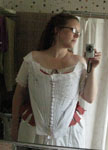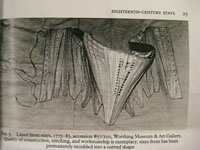First, I played a bit more with the JP Ryan stays pattern I had chosen for this project and became increasingly unsatisfied (with the boning layouts, and the idea of using a commercial pattern). I looked again at Lynne Sorge-English’s article on 18th c. stays and was reminded of the beautiful 1780s stays from the Worthing Museum (England)… which she helpfully patterns. Yay!
I’m going to be using this as the base pattern, adjusting it to fit me, changing the CF to be functional lacing rather than decorative, and using fancier fabric to cover — so not an exact recreation, but close enough.
So I worked on mocking these up over Labor Day weekend, and here’s where the Twilight Zone music comes in. I was happily scaling up and almost done, when I realized that I had forgotten that I had blown up the pattern on a copier to 200% (I think), and so the scale I was using was off by half. So then I remeasured, and found that the CF was only 6″. Ignoring the idea that these stays were worn by a pygmy, there’s no way that’s possible! The scale I had them at was a CF of 12″, which seemed far more reasonable. So I continued along my merry way with the scale that I was using (all the other pattern pieces seeming reasonably sized, of course), and made a mockup, and (insert Twilight Zone music) they kind of fit me (in fact, they were slightly too big). I know. This is weird. I am a generously sized, 5’11” modern woman. WTF, I say?
Not one to question a gift horse and all that, I sewed up my mockup, discovered it was slightly too big, and then started taking it in in various places — here you can see the various stages, from “too big” to “kind of right.” Note that I had waaay too little boning on hand, so only one side is boned, and even then not in every channel.
 |
 |
 |
|
 |
 |
 |
 |
Now I just need to find some time (the next month being JAM PACKED for me) to get some better mockup fabric, make another mockup, and then bat my eyes at Jenn to get her to do a fitting on me.
Now, on to quandries: I think I’ve “solved” my boning one in that I’ve thrown my dart as far as boning decisions go, and am sticking with the idea of using German/Wissner plastic boning (supported with some steel). I had long conversations over on LJ about this (thanks very much to all who weighed in) and here’s my logic: I want to make as accurate a reproduction as I can. I can’t get baleen (and I’m glad I can’t, because I don’t want to kill whales to make stays), so therefore I have to pick what is most like baleen. Reed/cane/wood is period, but was considered substandard and the research I’ve read (particularly in the Dorsey dissertation [full citation here]) says that reed/cane/wood was only used (in the US) in homemade, lower quality stays. German plastic boning is designed to be a baleen substitute, and while it’s not the same thing, it’s closer in properties than reed/cane/wood… or so it seems. Who knows, the point is I have to throw a dart, and there’s no one choice, so that’s what I’m going to try for this project.
But I am still in a quandry about fabric! Obviously, linen is what is period — my research tells me that linen buckram stiffened (I forget what with – gum arabic?) is what was used in the period, and we can’t get that now. I’ve considered using coutil, but I’d really like to at least try to be more historically accurate in my fabric choice. So I’ve been emailing with Angela Burnley of Burnley & Trowbridge who has been immensely helpful in suggesting fabrics, and who mailed me some fabric swatches to choose from. Some of them seem a little loosely woven, or have a bit of stretch, so those are out… I had thought I had nailed it down to one of the heavier/no stretch fabrics, but then I showed the swatches to Jenn & Cynthia and they both think the fabrics are too light to support the bones/not have the bones wear through. So, I turn to you, fabulous people, to tell me — what kinds of linen fabric have you used in your stays, and has it held up? I have heard the suggestion to use linen artist’s canvas, but that runs about $60/yard and I’d like to avoid paying that much if possible.
In case it helps, here’s a picture of the swatches from B&T — I know that you can’t actually feel them, which is what you really need to do:


I’ve been using the Italian linen (5417) and been very pleased. I thought it was a little light at first, but once I started working with it really liked the weight. I used two layers in my new 18c stays (along with wool outer and lightweight linen lining) and one in the Frances Stuart dress (with a lightweight lining) and one (again, with a lightweight linen lining) in my new kirtle.
Stretching hasn’t been an issue at all, even though I wouldn’t mind the Frances Stuart stretching a bit. Though none of the things I’ve made have had huge amounts of wear, the new 18c stays have been through more than any other corset I’ve made and there’s no sign of anything wearing through. As you know, I used reed which is so grippy that you really don’t even need to close the boning channels for it to stay in place. I would think that plastic, while it wouldn’t be as grippy as reed, also wouldn’t be as slippery as metal and therefore you wouldn’t have to worry about the ends as much.
Hi! the new layout is really nice!!!! for the interlining, I always used unbleached jeans, it’s cheap, natural, not too heavy and…
period! read Nora Waugh’s corsets and crinolines at the end on making stays.
Well, maybe, this was not jeans as we know it today but you can have a try.
The Diderot Blue Waugh corset (http://i262.photobucket.com/albums/ii90/philcostumes/dessous/corsetDiderotface.jpg) is made that way and so is the other Waugh corset.
OR there are some chimical products to stiffen a common linen fabric or coton, but forget it…. it’s really messy.
Good luck!
Hey Kendra,
I actually made my pair of 18th century stays with a tight weave linen from Burnley and Trowbridge (I took their stays making workshop) and it worked out very nicely. I used two layers – one very dense linen, and then a lighter more decorative linen for the cover. It’s surprising how much it holds up. Hope that helps a bit. You can always ask Angela what she sells to her stays making course.
Thanks everyone! You’ve made me feel better about using one of the B&T linens. I think I’ll go with whichever seems sturdiest — two layers of that, plus one lighter linen (or cotton) for lining, plus a decently heavy damask for covering is the plan, and that sounds like it’ll be enough!
Wouldn’t pre-shrinking the linen a couple of times in hot water help tighten up the weave? I really like how well the corset shapes, even without half the boning! 🙂
I’m a fine artist. Are you aware you can just get gum arabic from art supply stores? You actually might be able to make your own gum-stiffened linen. Art supply stores also sell fabulously high-quality linen, but it’s mighty expensive (on the other hand, it’s often 120 inches wide, so you don’t need a lot). It’s meant to be glued, stiffened, stretched and nailed to a frame and then to hold up as a painting for centuries. Loose weaves are still pretty strong too.
Good luck. Your projects sound fascinating.
Um, if this could be folded into the previous post …
I didn’t say how many types of linen you can get at art supply stores. Places like New York Central Art Supply have (or had as of a few years ago) dozens of different linens, in textures from pure burlap to the finest, silkiest, smoothest airplane linen. Most big art supply stores should have at least a half dozen of excellent, unprimed (no paint!) linens.
Kendra,
RE: stiffening, have you tried rice starch from a bookbinders? you can get it online for under $10 a pound . It works a treat to stiffen fabric for ruffs. Veronica
What a great shape! I love how the boning layout supports vertically as well as along the seam lines – I’m guessing that it will make for sturdier tabs that way.
I will have to pick your brain (and borrow that article!) when I get around to redoing my 18thc stays. Someday!
If it would be helpful to you, I have some photos of the interior of a set of stays in the collection of Berrington Hall (formerly Snowhill). These stays are without their lining, so you can see all the interior construction, and what kind of linen the interlining looks to be – one of the few garments one prefers to find incomplete! lol
If you’d like I can email them to you, a few are pretty decent. I can do the same for anyone else too, they just cannot go online as I don’t have permission for that and would like to keep in the curator’s good-books.
Funnily enough, I’ve just been adding info from that article by Sorge-English into my thesis, lol.
Re: your pattern scaling up to big: I used Jill Salen’s 1760s stays pattern (which I am certain is actually 1780s) and found when I scaled it up that it was much too big for me, and I’m not tiny. I wonder if the problem is that 18th century women were proportionally much shorter in comparison to their width than we are, so once we make the stays long enough, they are too wide around? It would make sense, as improved nutrition has a greater effect on height than width… I’m glad that I’m not the only one having ‘too big’ problems. If even you are, I know it isn’t just that I did something really stupid!
Also, have you thought of using cotton for your stays? It is accurate for late 18th century stays: both the original stays that Salen worked from and a very similar pair in KCI are cotton. The shape is very similar to the red wool pair you are working from (those are V&A – right?).
Finally, I love your new site!
I really love your website! There is so much useful info here that was hard to find anywhere else. Keep it up, and good luck on your projects!
Have you ever tried using duck linen canvas? I used it for my 1750’s stays, as it has a marvelously stiff and tight weave. I got it at Joann Fabrics for about $7.00 a yard, but I think you can find it cheaper on eBay. Hope this helps. 🙂
Can you post Lynne Sorge-English’s article and the 1780’s stays pattern on this site? If you could, I would greatly appreciate it.
Angelica
I too am a little keen to have a peek at this pattern. Your stays are looking great! cheers!
Hi Angelica and Cazonetta — unfortunately I can’t post the pattern online, as I only have a photocopy and it would be a violation of copyright (I know, I know, but I’m a librarian!). You can, however, either get the article from a library or buy a copy of the journal — check bookfinder.com, I’m sure you’ll find it there and I doubt for too much money.